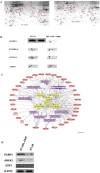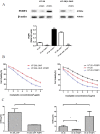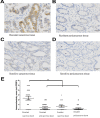Poly(C)-binding protein 1 mediates drug resistance in colorectal cancer
- PMID: 28076324
- PMCID: PMC5355098
- DOI: 10.18632/oncotarget.14516
Poly(C)-binding protein 1 mediates drug resistance in colorectal cancer
Abstract
Oxaliplatin (L-OHP) is standard treatment for colorectal cancer. However, resistance to L-OHP often leads to treatment failure or cancer relapse. Understanding of the mechanism underlying L-OHP resistance is important to overcome the resistance and improve colorectal cancer treatment. This study aimed to identify new proteins that mediates L-OHP resistance in colorectal cancer and elucidate their mode of function. HT-29 cells were exposed to gradually increased concentration of L-OHP to select L-OHP resistant HT-29/L-OHP cell line. Proteomic analysis of HT-29 and HT-29/L-OHP cells were performed to identify differentially expressed proteins, including Poly(C)-binding protein 1 (PCBP1). PCBP1 expression level in 20 cases of L-OHP sensitive patients and 20 cases of L-OHP refractory patients was analyzed by immunohistochemistry. Chemoresistance and Akt activation in HT-29 and HT-29/L-OHP cells were analyzed by MTT assay and Western blot analysis. We identified 37 proteins showing differential expression in HT-29/L-OHP and HT-29 cells. In particular, PCBP1 protein level increased 15.6 fold in HT-29/L-OHP cells compared to HT-29 cells. Knockdown of PCBP1 sensitized HT-29/L-OHP and HT-29 cells to L-OHP, while overexpression of PCBP1 increased L-OHP resistance in HT-29 cells. In addition, PCBP1 expression was significantly higher in tumor samples from L-OHP refractory patients than in those from L-OHP responsive patients. Furthermore, we found that knockdown of PCBP1 inhibited the activation of Akt in HT-29/L-OHP and HT-29 cells. In conclusion, our findings suggest that PCBP1 is a molecular marker of L-OHP resistance in colorectal cancer and a promising target for colorectal cancer therapy.
Keywords: chemoresistance; colorectal cancer; oxaliplatin; poly(C)-binding protein 1.
Conflict of interest statement
The authors declare that there are no conflicts of interest.
Figures





Similar articles
-
Knockdown of ADAM17 inhibits cell proliferation and increases oxaliplatin sensitivity in HCT-8 colorectal cancer through EGFR-PI3K-AKT activation.Biochem Biophys Res Commun. 2018 Sep 18;503(4):2333-2339. doi: 10.1016/j.bbrc.2018.06.158. Epub 2018 Jul 2. Biochem Biophys Res Commun. 2018. PMID: 29964008
-
Gene and protein expression in the oxaliplatin-resistant HT29/L-OHP human colon cancer cell line.Genet Mol Res. 2015 Sep 21;14(3):11013-22. doi: 10.4238/2015.September.21.14. Genet Mol Res. 2015. PMID: 26400331
-
[MiR-145 inhibits drug resistance to Oxaliplatin in colorectal cancer cells through regulating G protein coupled receptor 98].Zhonghua Wei Chang Wai Ke Za Zhi. 2017 May 25;20(5):566-570. Zhonghua Wei Chang Wai Ke Za Zhi. 2017. PMID: 28534337 Chinese.
-
Splicing factor poly(rC)-binding protein 1 is a novel and distinctive tumor suppressor.J Cell Physiol. 2018 Jan;234(1):33-41. doi: 10.1002/jcp.26873. Epub 2018 Aug 21. J Cell Physiol. 2018. PMID: 30132844 Review.
-
Decoding poly (RC)-binding protein 1 (PCBP1), the underrated guard at the foothill of ferroptosis.Pathol Res Pract. 2025 Feb;266:155771. doi: 10.1016/j.prp.2024.155771. Epub 2024 Dec 12. Pathol Res Pract. 2025. PMID: 39700662 Review.
Cited by
-
Biomarker Identification through Proteomics in Colorectal Cancer.Int J Mol Sci. 2024 Feb 14;25(4):2283. doi: 10.3390/ijms25042283. Int J Mol Sci. 2024. PMID: 38396959 Free PMC article. Review.
-
The Pivotal Player: Components of NF-κB Pathway as Promising Biomarkers in Colorectal Cancer.Int J Mol Sci. 2021 Jul 11;22(14):7429. doi: 10.3390/ijms22147429. Int J Mol Sci. 2021. PMID: 34299049 Free PMC article. Review.
-
Variations in clinical features and oncologic behaviors of T1 colorectal cancer according to tumor location.Int J Clin Oncol. 2020 Jun;25(6):1130-1136. doi: 10.1007/s10147-020-01642-9. Epub 2020 Mar 2. Int J Clin Oncol. 2020. PMID: 32124095
-
Poly C Binding Protein 1 Regulates p62/SQSTM1 mRNA Stability and Autophagic Degradation to Repress Tumor Progression.Front Genet. 2020 Aug 14;11:930. doi: 10.3389/fgene.2020.00930. eCollection 2020. Front Genet. 2020. PMID: 32922440 Free PMC article.
-
Gambogic acid reverses oxaliplatin resistance in colorectal cancer by increasing intracellular platinum levels.Oncol Lett. 2018 Aug;16(2):2366-2372. doi: 10.3892/ol.2018.8916. Epub 2018 Jun 6. Oncol Lett. 2018. PMID: 30008940 Free PMC article.
References
-
- Knudsen AB, Zauber AG, Rutter CM, Naber SK, Doria-Rose VP, Pabiniak C, Johanson C, Fischer SE, Lansdorp-Vogelaar I, Kuntz KM. Estimation of Benefits, Burden, and Harms of Colorectal Cancer Screening Strategies: Modeling Study for the US Preventive Services Task Force. JAMA. 2016;315:2595–2609. - PMC - PubMed
-
- Sato S, Itamochi H, Kigawa J, Oishi T, Shimada M, Sato S, Naniwa J, Uegaki K, Nonaka M, Terakawa N. Combination chemotherapy of oxaliplatin and 5-fluorouracil may be an effective regimen for mucinous adenocarcinoma of the ovary: A potential treatment strategy. Cancer Sci. 2009;100:546–551. - PMC - PubMed
-
- El-akawi Z, Abu-hadid M, Perez R, Glavy J, Zdanowicz J, Creaven PJ, Pendyala L. Altered glutathione metabolism in oxaliplatin resistant ovarian carcinoma cells. Cancer Lett. 1996;105:5–14. - PubMed
-
- Arnould S, Hennebelle I, Canal P, Bugat R, Guichard S. Cellular determinants of oxaliplatin sensitivity in colon cancer cell lines. Eur J Cancer. 2003;39:112–119. - PubMed
MeSH terms
Substances
LinkOut - more resources
Full Text Sources
Other Literature Sources
Medical
Molecular Biology Databases
Research Materials
Miscellaneous

